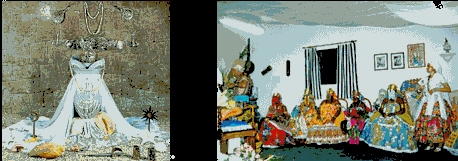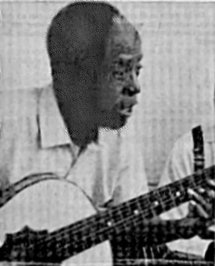|
|
|
Notes on Samba...
Origins of Samba - Candomble and the Music by Paul F. Clifford One history of Samba begins with Duque, a white Brazilian who had a Dance academy in Paris, returning to Brazil on one of his rare trips back home. In Rio De Janeiro he encountered the band "Oito Batutas" (the eight experts). There was a uniqueness about their music and he used it to reinterpret the steps of the Maxixe to match the music and took both the band and the new dance back to Paris. This is the "white" history for the origins of Samba. The "black" history of Samba is a little more elaborate. The first known mention of the word Samba in Portuguese was by the priest Miguel do Sacramento Lopes Gama. Lopes used the word to ridicule and describe a variety of music and dance originating with the "blacks". During fourteen years, between 1832 and 1846, he published in Recife and Corte a series of satirical articles entitled "O Carapuceiro". In an 1838 edition Lopes makes reference to "samba d'almocreves" (almocreve was the servant that took care of the mules and donkeys). Lopes was opposing the new rhythm that was being listened to in the dance halls (presumeably the lundu). Also we read... |
|
Aquí pelo nosso mato
Qu´estava então mui tatamba Não se sabia de outra coisa Senão a dança do samba |
Around our village here
Which was quite stupid by then There was nothing else we knew Besides the samba dance |
|
From a European viewpoint, the history of Brazil and Cuba have many differences. However, for the West Africans forced into slavery in these strange lands (and their descendants), the histories have a lot of similarities. Particularly fortuitous, from a musical and dance viewpoint, is the way the Africans managed to preserve their religious traditions by making them part of their observance of Catholic ritual and daily life. In today’s world the sounds of Mambo/Salsa and Samba are undeniably linked to these West African religious traditions. The West African belief system involves becoming one with your orixá (god/saint), your protector and helper. The concept is similar to the Catholic view of praying to the saints. The similarities between the two concepts allowed the Africans to conceal their beliefs by disguising their orixá as Catholic saints. In both Cuba and Brazil the church (from a generational viewpoint) tolerated this syncretism as a means of Christianising the slaves. However, it suppressed celebration of the native rituals that went with the West African belief system. To the African, dance and song is worship. So, they could conceal the worship of their orixá by disguising the ceremony as a party. This didn’t completely fool the authorities and even up until the early twentieth century, police often raided "suspect parties". The need for secrecy made it necessary to conceal the meaning of certain dances and songs from the uninitiated. At times, to the annoyance of the "tias" (Candomble priestess), musicians revealed and at the same time preserved the secret rhythms by mixing them with more accepted musical forms. Oita Batutas, the band, did this with their music. The Afro-Cuba religion of Santeria, preserved the hypnotic rhythm that is the basis of "Mambo" (Mambo means: conversation with the gods). In Brazil the rituals of the Afro-Brazilian religion of Candomble gave rise to a series of dances and in the twentieth century the "Samba". To adherents of Candomble, the word Samba, means to pray, to invoke your personal orixá (god). |

|
In Candomble an initiate seeks out their axé , the spiritual force which sustains them. To increase the axé they carry out daily devotional rites and perform ritualistic ceremonies. In these ceremonies, drummers play a sequence of rhythms, each corresponding to the orixá (saint/god) being summoned, while devotees sing songs and execute dance steps associated with their personal orixás. It is from these rituals that the variety of sambas that exist in Brazil have their roots. Donga (Ernesto Joaquim Maria dos Santos, 1889-1974) is credited with composing the first song registered as a samba carnavalesco, "Pelo Telefone" - "On the Telephone" (1916). The piano score was written by his friend Pixinguinha. Pelo Telefone was recorded by their band Oita Batutas in 1917 and became a great success at the 1917 carnaval! |
 Donga
Donga
|
Donga’s music was influenced by his frequent visits to the house of Tia Ciata, a Condomble priestess from the state of Bahia who lived near the Praça Onze in Rio de Janeiro. Praça Onze was the gathering place of ex-slaves and immigrants from the northeast of Brazil. There, the young musician encountered music forms like the samba de roda (ring samba), the jongo, and the afoxé. In 1922 Donga, Pixinguinha and the other members of the band Oita Batutas took the band's unique music to Paris and toured with the Maxixe dancer, Duque. There they blended Jazz influences with their own unique sound. After their return from Paris in 1923, composers including Donga, Pixinguinha, Sinhô (José Barbosa da Silva), and Heitor dos Prazeres experimented with different instruments and sounds and established the genre called Samba-Carioca. In 1933, Samba-Carioca was introduced to the world, when Fred Astaire danced it in the movie, Flying Down to Rio. 
The modern day Samba-Carioca, the basis of ballroom Samba, which was popularised in the UK and USA throughout the 1930s and 1940s was created in Rio de Janeiro as the result of the urbanisation of what had been previously a rural based music. The samba rhythms were brought to Rio by refugees fleeing from Bahia in Brazil’s north east. Bahai was the primary destination of most of the slaves transported to Brazil over three centuries and (even today) has the largest black population within Brazil. Slavery was abolished in Brazil in 1888, and this permitted and in some cases necessitated greater mobility amongst the population of Bahia. In the beginning of the twentieth century war, famine and drought and the hope of a better future drove many blacks to migrate south where they began to populate the hills surrounding Rio. This urbanisation of the Bahia culture led to greater exposure of black music and dance. Many recordings of "black" music were made before and after the introduction of Radio in Brazil. However, because of the limitations of early recording methods only certain instruments could be recorded and this put restraint on the music that could be played. In the later part of the 1920s, the new electronic method of recording allowed a greater range of instrumentation to be recorded and as technology developed so did the music. Prior to the introduction of radio in 1923, most "white" music and culture in Brazil had been "imported" from Europe. With the advent of radio the young urban "white" middle class regularly heard and responded to the "black" music that previously they had only heard through poor mechanical recordings. Ultimately, this allowed the music to acquire respectability and Samba the dance was eventually adopted by the urban middle class. By the late 1920s, in the labourers' quarters of the Cidade Nova, the "new city of Rio", there lived former black slaves and Caboclos nordestinos who had fled the north east of Brazil. In the 1920s these inhabitants of the Morros de Rio agreed on the fact that Samba was a common musical language, which previously was only known, in the Candomblé centres and bars of the Lundus, Batuques and Bahia Ranchers. They also agreed that the Maxixes and Choros, by musicians like Donga, Sinho and Pixinguinha, were their own new and particular form of Carnival music. Almost everything in the line of urban Rio music, from Choro to Samba, originated from the Cidade Nova, with its Praça Onze, the Samba schools and Boates. Even the Bossa Nova, which became popular in the 1950s/1960s, which according to general opinion was the creation of middle-class white youths from the southern zones stretching from Leme to Leblon, would never have come to being without the already existing Samba-Canção basis on which it was built. 1928 was a special year for Samba. A French dance book published by Paul Boucher in 1928 included Samba instructions, this helped popularise the dance in Europe but more importantly, on August 12, 1928 the first samba school was established at Estácio. Adopting the title of Deixa Falar ("Let Them Gossip"), the school's name and debut were a subtle snub at the upper classes. One of the founders, Ismael Silva, said that although it was really just a club, they called it a school because nearby was an old teachers college and we reasoned that "we also teach, but here we learn the samba!" Nilton Bastos, Bide and Marçal were also founders and all became famous with a number of hits during the Golden Era of Brazilian radio. Also in 1928 the second Samba school opened, Bloco (of the Carnival) dos Arangueiros in Mangueira. founded by Cartola and Cachaca (Carlos Moreira de Castro). A year later another Samba school emerged through a joint venture formed by this Bloco and others from Morro: the G.R.E.S. (Gremio Recreativo Escola de Samba) Estação Primeira (first train station) de Mangueira. By 1930 the worldwide economic crisis had had its impact on Brazil and weakened the coffee planters' hold on the government. An opposition Liberal Alliance was formed with the support of nationalist military officers. When the Alliance lost elections in 1930, the military seized power on their behalf and installed the Liberal leader, Getúlio Vargas, as president. Vargas, whose regime was inspired by Mussolini's and Salazar's fascist states, dominated the political scene for the next 30 years, until he was forced out of office in 1954. In the 1930s, with the collapse of world prices for coffee and other commodities, the backbone of Brazil's economy was shifting from plantations to industry. As people moved into the cities, politicians seeking a new electoral base began to reach out to the common Brazilian. An entire shift in Brazilian society (especially in the cities) started to happen. An important element of this, in a country whose population was about half black, was a new sense of respect and valorisation of the Afro-Brazilian heritage. In the 1930s, when Brazil was ruled by President Getulio Vargas, the city of Rio began to subsidise parade groups who danced samba during Carnival - subsidies were dependant on the performers presenting a patriotic theme. One of the patriotic themes that was used over and over again, and is still used, is the idea that Brazil is a racial democracy, a place where the African heritage gets its due and is honoured. This was the official image that the government wanted to promote. The government not only promoted samba, but a more African samba! Around 1900, samba was mostly performed using European instrumentation flute, strings, and small hand-held percussion instruments. In the 1930s, samba troupes began to add a set of big African drums called the "battuque." Earlier in the century, whites would have considered drums to be too African and in very poor taste. It was this new freedom to be "black" which encouraged samba to grow and mature and develop into the musical form that we find today. In 1929, a group of white middle class youths who had a band that performed at weddings and socials were invited to record their music. They reformed their band and called it Bandos Tangarás. The band's members were Henrique Foréis (Admiral), Carlos Alberto Braga (João de Barro), Henrique Brito and Noel Rosa. In 1930, Noel Rosa wrote the hit Samba "Com que Roupa?" In the late 1920s, Noel Rosa, "hung out" with the sambistas of Estácio de Sá and of the morros (hills), learning from them the rhythm and style of their compositions and songs. He had a fondness for percussion instruments and a fascination with the malandros, those living on the fringe of society with their cunning and criminal behavior. They came from the morros, hills of Rio and brought their own style of music with them. Rosa incorporated their style of composing into his own, marking definitively the dissemination and acceptance of samba as music of quality, contributing to eliminating the concept that samba was música negra, black music; coisa de negro, thing of the negro, or coisa de bárbaro, thing of the barbarian It is said that Noel Rosa (1910-1937) was the first to foreground the lyrics of samba and to break with conventional themes and approaches. He set the foundation stone for a new vocal form of Samba to be developed in the future years! To continue click here! . . . Part 3 - Samba 1929 to Present Other articles in the Origins of Samba series
|
|
Press Ctrl-D to Bookmark this page!
Something new will appear at StreetDance most months. Stay up-to-date! Sign up for our free newsletter! Email us! If you enjoyed StreetDance's articles. Tell your friends about this site! Email them! If you found something lacking, tell us and it will be fixed! Tell us what you would like to read about! So talk to us! Feedback. StreetDance@mail.com |
Got a question? Click here! Want to know something more about Latin StreetDance click on one of the followng Dance History Mambo, Cha Cha & Salsa | Merengue | Samba Latin Dance Technique Feeling | Technique | Tricks & Tips | The Yambus | The Clave Basic Timing and Steps Mambo | Cha Cha | Salsa | Merengue | Samba Basic Choreography Mambo, Cha Cha & Salsa | Merengue | Samba Other Stuff Articles | Gig Guides | Dance Videos | Classifieds | Links | Home |
This page was last updated November 2000
copyright Paul F Clifford (2000)
